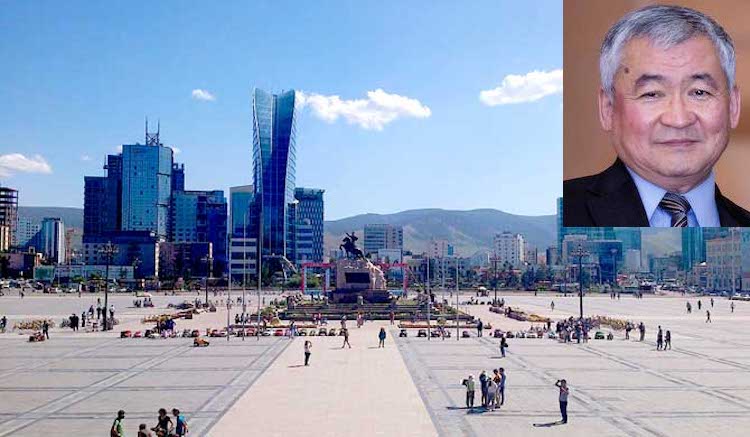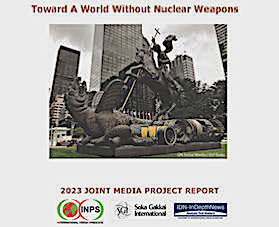By Radwan Jakeem
|視点|非核兵器地帯に関する第二の包括的な研究が必要(ジャルガルサイハン・エンクサイハンNGO「ブルーバナー」代表、元モンゴル国連大使)
【ウランバートルIDN=ジャルガルサイハン・エンクサイハン】
8月の核不拡散条約第10回再検討会議を前にして、モンゴルの首都ウランバートルで非核兵器地帯の課題と今後に関して意見を交換するNGO会議が開かれた。非核兵器地帯は、不拡散と核軍縮に資する非核兵器国の重要な実践的、地域的措置として認識されているものである。
核兵器の脅威とその拡散を予防する最も効果的な方法は核兵器の廃絶であるという意見で参加者らは一致した。核兵器禁止条約の発効は、核兵器をさらに非正当化し、核兵器廃絶に向けたグローバルな規範を強化する法的枠組みを提供するものであるという見解を参加者は強調した。しかし、それだけでは不十分だ。今日の急速に変化する地政学的な情勢の下で、非核兵器地帯はより大きく、より積極的な役割を果たす必要がある。非核兵器地帯の概念と実践は巨大かつ建設的な可能性を秘めているからだ。
現在、海底と南極、宇宙空間は居住人口のない非核兵器地帯とされている。また、居住地域には、ラテンアメリカ及びカリブ地域、南太平洋、東南アジア、アフリカ大陸全体、中央アジアの5カ所に非核兵器地帯がある。116の国と8400万平方キロメートルが含まれ、これは世界の人口の39%と国連加盟国の60%を占める。これらの地域的地帯は旧来型の非核兵器地帯であり、これとは別に、モンゴルが一国で非核兵器地位を認められている。
旧来型の非核兵器地帯の数が増えれば、その集団的な存在感は重みを増し、核兵器なき世界を確立するという目的にさらに資するものとなるだろう。非核兵器地帯の信頼性を高めより効果的なものにするために、5つの法律上の核兵器国全てが非核兵器地帯の議定書に速やかに署名・批准し、非核兵器地帯の地位に影響を与える留保あるいは単独での解釈を取り下げる必要がある。従属的な領域に対する国際的責任を負っている国家は、その責任が非核兵器地帯やその領域の住民の正当な利益に影響を与えることのないようにする必要がある。
ウランバートル会議の参加者らは、非核兵器地帯の役割を検討するにあたって、現在の非核兵器地帯概念の主要な弱点の一つは、個別の国家が非核兵器地帯を確立することを排除しているNPT第7条の規定【1】と、このNPTのアプローチを反映して国連総会が1975年の決議3472(XXX)で提示している非核兵器地帯の定義に関連していると考えた。この定義によれば、非核兵器地帯は「関連する地域の諸国家間の自由意思による取決めを基礎として」確立される必要があるとされている【2】。
こうしたアプローチでは、こうした地域的地帯の一部に個別国家が加わることが排除されてしまう。もちろん、1975年の「非核兵器地帯のあらゆる側面に関する包括的研究」では、こうした地帯は一群の国家によってのみならず、大陸全体、さらには個別国家によって確立され得ることを確認しているのであるが。今日、このことは単に学術的な意味合いを持つだけではなく、より広範な実践的、地政学的な意味あいを持っている。総じて見るならば、これらの個別国家及びその主権の及ぶ領域は、中東アジア及び東南アジアの国々とその主権の及ぶ領域をはるかに凌駕しているのである。
さらに、集団的アプローチのみで事に当たることは、国連憲章に盛り込まれた主権国家平等の精神そのものや、安全保障への権利を含めた国際法の基本原則にも背くことになる。この問題については、国際司法裁判所の勧告的意見をこの件に関して求めることもできよう。非核兵器地帯の定義にあたって、先の国連総会決議は、「非核兵器地帯の特定の事例に関して採択された、あるいは今後採択されるかもしれない国連総会決議、あるいは、そうした決議から生じる国連加盟国の権利を損なうものではない」と認めているのである【3】。その決議が、一部の反対票と一部の棄権票を含む投票によって採択されたのも不思議ではない。
現在検討の対象になっているのは、中東において非核・非大量破壊兵器を創設することである。北東アジアや北極に非核兵器地帯を創設することに関する非公式な意見交換も進められている。しかし、地理的な位置の問題や、政治的あるいは法的理由のために、こうした集団、すなわち旧来型の地帯の一部とはなることができない数多くの小規模国家が存在する。こうした「弱い部分」が加われば、非核兵器世界が強力になることを我々はみな認識している。
こうして、時代遅れの非核兵器地帯の定義を見直し、これらの非核兵器国の非核世界への参加を排除しないようにしなくてはならない。そうでなければ、政治的な空白と国際法の抜け穴が作りだされ、対立する核兵器国家がそれを利用して地政学的なアドバンテージを得ようとすることになるだろう。その結果として、急速に変化するこの世界で、空間と時間という要素が決定的ではないにせよ重要な戦略的要素になりつつあるこの時代において、特定の地域だけではなくより広い世界が不安定化することになる。
地理的な位置を理由に一部の非核兵器国を排除すれば、多数の国々だけが国際法で守られ、その他がそこから弾かれるというかたちで、非核兵器国間に分断を生むだけの結果に終わるだろう。したがって、第二の研究、この場合は、非核兵器地帯のあらゆる側面における真に包括的な研究がなされる必要がある。これは、ウランバートル会議で採択された声明で指摘されているように、非核兵器地帯のさらなる拡大を容認するようなアプローチを採り、さらに包摂的なものでなければならない。
モンゴルが2013年に提案したこの第二の研究は、この40年で積み重ねられた国家実践、豊かな経験、教訓に依拠して、第二世代の地帯の協議において有益なものとすることができるだろう。そのことによって、非核兵器地帯制度を弱める法的・政治的空白や抜け穴を埋めることができる。
第二の研究は、関心を寄せるすべてに国家によってなされ、すでに述べたように、非核兵器地帯に関連を持つ核五大国によって無条件に提供される安全の保証や、事実上の核保有国[訳注:NPTの核兵器国ではないインド・パキスタン・イスラエル・北朝鮮のこと]の役割を含むものでなくてはならない。また、一国非核兵器地帯の問題を取り上げ、旧来型の非核兵器地帯に入っていない非核兵器国に対して核五大国が一国非核地位を尊重し、その地位に違反するような行為に及ぶことがないとの保証(いわゆる安全の保証)を与えるべきであろう。
非核兵器地帯に関する第二の研究を行うとの合意がNPT再検討会議でなされれば、NPT体制へのさらなる強化に向けた非核兵器国の実践的な貢献となるだろう。次回のNPT再検討会議は、会議の議題に盛り込まれたその他の問題と並んで、この点の履行について再検討することもできよう。(06.16.2022) INPS Japan/ IDN-InDepth News
【注】
1.非核兵器地帯に関連したNPT第7条は「この条約のいかなる規定も(中略)地域的な条約を締結する権利に対し、影響を及ぼすものではない」と規定しており、これは現在の国際関係や国際法の規範を容認したものである。しかし、問題は、非核兵器世界への移行にあたってこれで十分なのかどうかということだ。
2.国連決議3472(XXX)号(1975年12月11日)
3.同上
p>NEW YORK (IDN) — A Joint International Health Statement for the 1st Meeting of States Parties (1MSP) of the Treaty on the Prohibition of Nuclear Weapons (TPNW) has stressed the urgent need to eliminate nuclear weapons as a matter of global health and survival. The joint statement expresses a "united voice" of physicians, nurses, public health professionals, and medical students worldwide. [2022-06-11]
The statement issued on May 2, 2022, provides an "updated evidence" on the catastrophic consequences of any use of nuclear weapons, the acute and growing danger of their use, and the impossibility of any effective humanitarian and health response following nuclear explosions on Parties (1MSP) of the TPNW.
"The TPNW is based upon a body of indisputable evidence, documented by scientists, health professionals, and experts in crisis management and response, that the consequences of nuclear weapons use are catastrophic, global, and without remedy. The Treaty concludes—and we concur—that the prohibition and elimination of nuclear weapons is the only responsible course of action in the face of such consequences," notes the joint international health statement.
The statement goes on to say that the detonation of nuclear weapons produces incinerating heat, powerful shock waves and overpressures, ionizing radiation, an intense electromagnetic pulse, and massive amounts of smoke and soot that can alter the Earth’s climate.
"Unlike conventional weapons or other weapons of mass destruction, nuclear weapons instantaneously wipe out entire populations, level cities, and devastate the environment. They produce radioactive contamination that remains active for millennia, causing cancers and other illnesses that can persist across generations."
Moreover, adds the statement, the environmental consequences of nuclear war, including severe climate disruption, can lead to global famine and, in the most extreme case, human extinction. No meaningful medical or disaster relief response to the detonation of nuclear weapons is possible.
Since the adoption of the Treaty, new data about climate effects has been published documenting the impacts from both limited and large-scale nuclear conflicts. IPPNW has submitted a briefing paper to the 1MSP that summarizes the blast, heat, and radiation effects of nuclear weapons, as well as the global impacts of nuclear war on climate, nutrition, and food security. This evidence should continue to drive the process of implementing the Treaty, its prohibitions, and its positive obligations.
The world has not been this close to nuclear war since the Cuban Missile Crisis of 1962. If the conflict in Ukraine were to escalate to the use of nuclear weapons, the consequences would almost certainly be global and catastrophic. Therefore, diplomacy is urgently needed to remove the danger of nuclear escalation in the current crisis, and needs to progress to negotiations among all nuclear-armed states to eliminate their nuclear arsenals under strict verification and timelines.
The joint statement adds: As the World Health Organisation has stated, nuclear weapons pose the greatest immediate threat to human health and welfare. The elimination of nuclear weapons is the only way to put an end to this preventable and intolerable threat.
"As member and observer states prepare to meet in Vienna for the first Meeting of States Parties, we call for prompt and universal ratification and implementation of the Treaty on the Prohibition of Nuclear Weapons.
The organizations signing the statement are:
-
International Council of Nurses (ICN) is the international federation of nursing organizations representing national nurses’ associations in 130 countries.
-
International Federation of Medical Student Associations (IFMSA) envisions a world in which medical students unite for global health and are equipped with the knowledge, skills and values to take on health leadership roles locally and globally. Founded in 1951, it is one of the world’s oldest and largest student-run organizations. It represents, connects and engages a network of 1.3 million medical students from 145 national member organizations in 134 countries.
-
International Physicians for the Prevention of Nuclear War (IPPNW) is a federation of health professional organizations in 55 countries dedicated to the eradication of nuclear weapons IPPNW received the Nobel Peace Prize in 1985, and founded the International Campaign to Abolish Nuclear Weapons (ICAN), which received the Nobel Peace Prize in 2017.
-
World Federation of Public Health Associations (WFPHA) is an international federation of 130 national and regional public health associations, representing 5 million public health professionals worldwide. WFPHA is the only worldwide professional society representing and serving the broad field of public health internationally.
-
World Medical Association (WMA) is an international organization representing physicians, with 115 national member organizations and thousands of associate members worldwide. [IDN-InDepthNews — 11 June 2022]
Image: Organizations signing the Joint International Health Statement. Source: IPPNW













